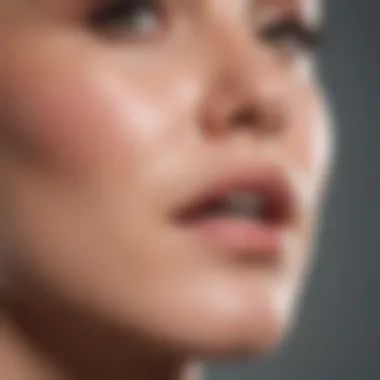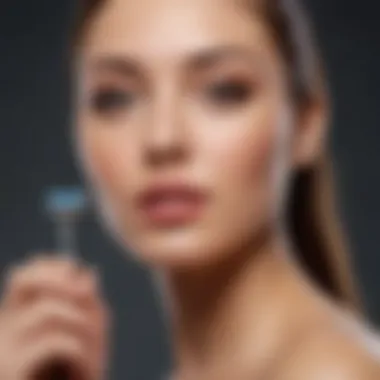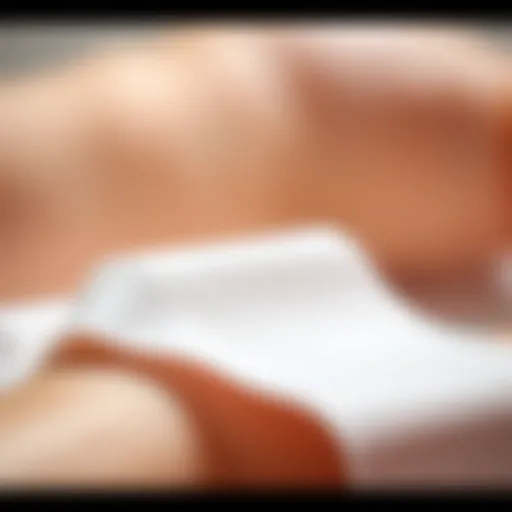Effective Methods to Remove Hair from Chin


Intro
Hair removal from the chin can be a sensitive topic for many women. The presence of chin hair is often a matter of concern and can affect self-esteem. Factors such as hormonal changes, genetics, and age can exacerbate this issue. This guide provides an in-depth examination of different methods for chin hair removal, catering to the unique needs and preferences of women across various backgrounds.
Understanding the different approaches can help women make informed decisions. Whether one seeks temporary methods or prefers a long-term solution, the categorization of techniques such as shaving, waxing, threading, and laser treatments is essential for clarity. This guide emphasizes not only the effectiveness of each method but also safety considerations that must be taken into account.
Tips and How-Tos
Skincare Routines for Different Skin Types
Before embarking on hair removal methods, a suitable skincare routine is crucial. Women with sensitive skin may experience irritation more than others. Here are some tips:
- Sensitive Skin: Use a fragrance-free, soothing cleanser and follow up with a gentle moisturizer. Avoid hot water and harsh scrubs.
- Oily Skin: Cleanse with a foaming or gel-based cleanser. Look for products with salicylic acid or tea tree oil to prevent clogged pores.
- Dry Skin: Opt for creamy cleansers and hydrating moisturizers. This will help in minimizing irritation during hair removal.
In addition to these basic routines, patch testing new products or hair removal techniques is wise. This minimizes the risk of allergic reactions.
Hair Removal Methods
Different methods can be explored for timely hair removal:
- Shaving: A quick and painless method. It requires frequent application.
- Waxing: Offers longer-lasting results. However, it may cause irritation in the sensitive area.
- Threading: Precise and effective, it is ideal for intricate shapes but may be uncomfortable.
- Laser Treatments: Provides permanent reductions. However, it's essential to choose reputable clinics, as techniques vary widely.
Post-Hair Removal Care
After any hair removal method, proper skincare is vital.
- Apply a soothing lotion or aloe vera gel to calm any irritation.
- Avoid using harsh products immediately afterward, which can exacerbate irritation.
Effective hair removal requires not just the right method, but also a suitable skincare approach tailored to individual needs, ensuring comfort.
Sustainable Practices
Choosing eco-friendly hair removal options has become a notable trend. Women increasingly seek products and practices that align with sustainable living.
When considering sustainable practices for hair removal:
- Eco-Friendly Razors: Many brands now offer reusable razors, reducing plastic waste significantly.
- Organic Waxing Products: Look for natural formulas without harmful chemicals, promoting environmental care.
- At-Home Treatments: Consider sustainable methods like sugar waxing, which requires fewer resources.
Embracing these sustainable practices fosters a more environmentally conscious beauty routine.
Celebrating Diversity in Beauty
The diversity in beauty deserves recognition. Hair removal preferences can vary greatly among different cultures, and inclusive brands are now addressing this wide array:
- Brands are becoming more diverse by offering products suited for various skin types and tones.
- Many cultures have unique hair removal traditions. Understanding these practices can enrich personal routines and foster appreciation.
Closure
"The key to effective hair removal is understanding your unique hair and skin types. This knowledge empowers better choices."
As this guide unfolds, it will delve deeper into each method’s nuances, examining their impacts comprehensively.
Understanding Chin Hair
Understanding chin hair is essential for anyone looking to effectively manage or remove it. Hair growth on the chin can be distressing for many women, significantly impacting their self-image. Knowledge of this topic helps in choosing the right approach to hair removal, allowing for methods that align with personal needs and skin sensitivity.
Chin hair is not just a cosmetic concern; it often has underlying biological factors. Understanding these factors can guide appropriate hair removal choices while ensuring skin health is not compromised.
The Biology of Chin Hair Growth
Chin hair growth is influenced by several biological factors, including hormonal changes and genetics. Androgens, which are male hormones naturally present in both men and women, play a crucial role in stimulating hair follicles on the chin. When androgen levels fluctuate, particularly during puberty, menopause, or as a result of certain medical conditions, hair growth can become more pronounced.
Another key factor is genetics. Family history can affect hair density and growth patterns. Some women may notice increased chin hair due to inherited traits passed down through generations. Recognizing that chin hair growth is a normal biological process can help in reducing feelings of embarrassment.
Chin hair growth can also be affected by some medications. For instance, certain hormonal therapies or steroids can alter the natural balance, leading to unwanted hair. Understanding these biological factors is crucial in deciding the most suitable hair removal techniques
Common Causes of Chin Hair


There are various reasons why chin hair may appear or increase. Some common causes include:
- Hormonal Imbalances: Conditions such as polycystic ovary syndrome (PCOS) can lead to excessive hair growth due to elevated androgen levels.
- Genetic Factors: Family history often plays a significant role in determining hair types and growth patterns, leading some women to have thicker or darker chin hair.
- Aging: As women age, hormonal changes due to menopause can trigger an increase in chin hair. The body's hormonal landscape shifts, resulting in changes to hair growth.
- Medications: Certain drugs can lead to unwanted hair growth. It is important to discuss potential side effects with a healthcare provider.
- Stress: Although the relationship is not well established, some studies suggest that high-stress levels can influence hormonal balance, potentially contributing to unwanted hair.
Identification of the cause of chin hair growth can enable more targeted approaches in dealing with the issue, whether through a hormonal evaluation or lifestyle changes.
Considerations Before Hair Removal
Before beginning any hair removal process, it is essential to evaluate personal factors that could influence the outcome. Understanding these considerations can enhance effectiveness and minimize potential complications. Proper awareness will also promote better choices tailored to individual needs.
Skin Sensitivity and Reaction
Each person's skin is unique, which means that reactions to different hair removal methods may vary widely. Sensitive skin may react negatively to certain products and techniques, leading to irritation, redness, or potential rashes.
To determine skin sensitivity, one might consider conducting a patch test. This test involves applying a small amount of the hair removal product on a discreet area of skin to observe for any adverse reactions before a full application. If irritation occurs, it may be prudent to seek alternatives that are gentler on the skin, such as products specifically marketed for sensitive skin.
When dealing with skin sensitivity, consider the following precautions:
- Read labels: Look for hypoallergenic formulas or those with soothing ingredients like aloe vera.
- Test temperatures: If using heated products like wax, ensure they are at a comfortable, safe temperature to prevent burns.
- Moisturize: Keeping the skin hydrated before and after hair removal can reduce irritation.
Individual Hair Type and Growth Pattern
Hair type and growth patterns are critical factors in choosing an effective hair removal method. Hair can vary in texture, thickness, and color, which influences how well various techniques work. For example, coarser hair may require stronger methods compared to fine hair. Additionally, understanding growth patterns helps assess how often hair removal needs to occur.
Things to consider include:
- Hair Texture: Fine hair may respond well to depilatory creams, while thicker hair may necessitate waxing or laser treatments for effective results.
- Growth Rate: Some individuals notice faster hair regrowth. Identifying how quickly hair returns can influence method choice, as some methods are quicker than others.
- Growth Orientation: The direction in which hair grows can also affect how easily it can be removed. Techniques like threading can be more effective on hair with specific growth patterns.
By carefully evaluating skin sensitivity and individual hair characteristics, one can significantly enhance the experience and results of the chosen hair removal methods.
Temporary Hair Removal Methods
Temporary hair removal methods provide immediate relief and a quick solution for those looking to address chin hair. These techniques can be very effective, although they require repetition and regular maintenance. Many women find these methods suitable for their beauty routines, especially when seeking quick fixes or before a special event. The importance of understanding these methods lies in their accessibility and convenience, often allowing for more choices tailored to personal preferences.
Shaving Techniques
Choosing the Right Razor
Choosing the right razor is crucial for a comfortable shaving experience. An ideal razor is sharp and appropriate for sensitive skin, reducing the risk of cuts and irritation. Many women prefer razors designed for facial hair, as they oftentimes have features that promote closer shaves without harming the skin. The key characteristic of a good razor is its ability to adapt to the contours of the chin and neck. A beneficial aspect of these razors is that they tend to be available at most stores, making them widely accessible. However, the wrong choice can lead to nicks or rashes on the skin, making this consideration significant in hair removal.
Technique for Effective Shaving
Employing the right technique for shaving is equally important as selecting the razor. Techniques such as shaving in the direction of hair growth can minimize skin irritation. Using a soothing shaving cream can enhance glide and protect the skin. The key characteristic here is the application of a light, gentle touch to avoid any unnecessary pressure. By following this method, many women successfully maintain smooth skin. However, it may require more frequent touch-ups compared to other methods, which might not appeal to everyone.
Waxing: A Closer Look
Types of Wax
Understanding the types of wax available can greatly influence the success of a waxing session. There are primarily two types: soft wax and hard wax. Soft wax is applied with a spatula and removed with strips, while hard wax hardens and is pulled off directly. The key characteristic is that hard wax is less likely to irritate sensitive skin, making it a favorable option for many. It can provide longer-lasting results than shaving, with hair often taking longer to grow back. Still, improper use can lead to skin discomfort.
Home Waxing vs. Professional Services
When considering how to wax, one dilemma is whether to choose home waxing or professional services. Home waxing kits can be convenient and cost-effective, best suited for those who feel confident in their skills. On the other hand, professional services offer the expertise of trained technicians who can perform the task with precision. The unique feature of professional waxing is the assurance of experience, reducing the likelihood of mistakes. While home waxing may save money, it carries the disadvantage of requiring practice to achieve similar results.
Threading: Precision Hair Removal
Benefits of Threading
Threading is a method that uses a thin thread to remove hair from the follicle. One of the standout benefits is the precision it offers, allowing for detailed shaping along the chin line. This technique is particularly attractive for those looking for defined results. The key characteristic of threading is that it can be less irritating than waxing, especially for those with sensitive skin. Nevertheless, it may not remove larger areas of hair as quickly as waxing or shaving, which can be seen as a downside for some users.
Finding a Skilled Technician
Finding a skilled technician is essential for successful threading. A proficient technician can assess skin type and hair density, adjusting the technique accordingly. Their expertise is invaluable as it offers peace of mind and enhances the experience. The unique feature of a skilled technician is their ability to create symmetry and precision, often resulting in more satisfying results. However, the downside is that trained professionals might charge a higher fee, making this method less accessible for regular upkeep.
Depilatory Creams: Usage and Efficacy
Choosing the Right Product


Selecting the right depilatory cream involves understanding individual skin types and sensitivities. Some products are formulated for sensitive skin, while others might be more aggressive in hair removal. The key characteristic is their ease of use, as they often offer painless hair removal within a few minutes. Depilatory creams can be a very easy alternative to more traditional methods, yet they require testing on a small skin area to avoid adverse reactions. If used incorrectly, they can lead to skin irritation.
Safety Precautions
Adhering to safety precautions when using depilatory creams is essential. Always read the instructions for application and timing closely, as leaving the cream on too long can irritate the skin. The key characteristic of these precautions is their necessity in maintaining skin health, as chemical burns are a potential risk. Educating oneself about the ingredients can provide further safety assurance. Still, despite the risks, many women find this method effective for immediate results.
Permanent Hair Removal Options
Permanent hair removal methods are essential for those seeking lasting solutions for chin hair. Unlike temporary options that require frequent repetition, these methods provide a more definitive answer to unwanted hair, saving time and effort in the long run. Each method offers distinct advantages and challenges, making it vital for the individual to consider personal preferences, skin types, and desired outcomes when selecting a permanent solution.
Laser Hair Removal: The Process
How It Works
Laser hair removal employs focused light energy to target hair follicles. The laser is absorbed by the pigment in the hair, damaging the follicles and inhibiting future growth. This process is effective for many skin tones and hair types, but is most beneficial for individuals with a high contrast between their hair and skin color. The precision of the laser allows for treatment in specific areas, like the chin, with minimal impact on surrounding tissues. A key characteristic of this method is its speed. Each pulse of the laser takes a fraction of a second, enabling the treatment of multiple hairs simultaneously. One significant advantage is its permanence; many patients experience long-lasting results with a series of sessions.
Expected Results and Sessions
Patients undergoing laser hair removal can expect a significant reduction in hair growth after completing the recommended number of sessions, which typically ranges from three to eight, spaced several weeks apart. The unique feature of this method lies in its ability to provide noticeable results relatively quickly. Initially, hair may shed after treatment, and with each session, the hair becomes finer and less visible. However, it is essential to understand that results can vary based on individual factors such as hair growth cycles and skin type. The method is popular due to its efficiency and long-term benefits but does require a commitment to attend multiple sessions for optimal outcomes.
Electrolysis: A Definitive Solution
Mechanism of Action
Electrolysis is a method that uses electrical currents to destroy hair follicles, ensuring permanent removal of hair. A tiny probe is inserted into the follicle, and an electric current is applied to eliminate the hair at its root. This method is effective on all hair colors and skin types, making it a versatile choice for many individuals. One of the primary advantages of electrolysis is that it treats each hair follicle individually, providing comprehensive results. Unlike laser treatments, electrolysis is effective for white, gray, and blond hairs, which do not respond well to lasers. However, because it addresses one follicle at a time, the process may require more time than laser hair removal.
Long-Term Considerations
When considering electrolysis, patients should be aware that while it offers permanent hair removal, the process can take longer to achieve full results compared to laser hair removal. The number of sessions required can vary greatly depending on hair density and the size of the treated area. Patients often experience some discomfort during treatments, and post-treatment care is crucial to minimize irritation. That said, many individuals find the long-term advantages of permanent hair removal outweigh the initial time commitment. Additionally, once completed, electrolysis eliminates the need for ongoing hair removal endeavors, which can lead to significant cost savings over time.
Aftercare Following Hair Removal
After hair removal, proper aftercare is crucial for maintaining skin health and ensuring a satisfactory outcome. This stage is often overlooked but plays an integral role in minimizing discomfort and preventing adverse reactions. Following hair removal, the skin can be sensitive and prone to irritation, making it essential to adopt a suitable aftercare routine. The focus here will be on two primary areas: skin care routines and monitoring for any side effects.
Skin Care Routines Post-Removal
Recommended Products
Choosing the right products for post-removal care is vital for effective recovery. It is essential to opt for products that are gentle and soothing. Look for those labeled as "non-comedogenic," as they won’t clog pores. A good option is aloe vera gel. Its soothing properties help calm the skin after the removal process, reducing inflammation and redness. Moreover, creams with hyaluronic acid can help maintain hydration, which is important for skin recovery after irritation.
A unique feature of recommended products is their availability in both gel and cream forms. Gels tend to feel cooler on the skin, while creams provide a richer barrier, offering sustained moisture. Both have advantages; for instance, gels absorb quickly, making them ideal for daytime use, whereas creams may be preferable at night for prolonged hydration. Choosing based on your skin type can optimize recovery after hair removal.
Managing Irritation
After hair removal, skin irritation is a common concern. Therefore managing irritation effectively is necessary to achieve comfort and prevent long-term damage. Various methods exist, starting with using cold compresses. Applying a cool compress can reduce swelling and discomfort.
Furthermore, over-the-counter hydrocortisone cream can be beneficial. This cream can alleviate inflammation and soothe itchy skin. However, it is crucial to use it sparingly as prolonged use may lead to skin thinning. The unique aspect of this approach is that while it provides quick relief, it is essential to monitor skin response to ensure no adverse reaction occurs. Remember, each person’s skin is different, so what works for one may not work for another.
Monitoring for Side Effects
Finally, keep an eye on your skin for any unusual reactions. Common side effects might include redness, swelling, or even blistering, depending on the method used for hair removal. Regularly checking the skin condition post-treatment helps identify early signs of infections or allergies.
If any side effects persist beyond a few days, consulting a healthcare professional may be necessary. In most cases, minor redness will subside, but understanding your skin’s response is crucial for future hair removal sessions. Awareness of your unique skin characteristics will lead to informed choices for the next time you consider removing chin hair.
Holistic Approaches to Hair Management
In the quest for smooth skin and effective hair removal, holistic approaches can provide valuable insights. These methods focus on nurturing the body internally to influence external results. This perspective understands that what goes on inside the body can significantly affect hair growth patterns. The emphasis is on both nutrition and natural remedies, promoting a more balanced method of managing chin hair.
Diet and Its Impact on Hair Growth
Nutrient-Rich Foods
The consumption of nutrient-rich foods plays an essential role in overall hair health. Foods that are high in vitamins and minerals help regulate hormonal balance. This balance can reduce the occurrence of unwanted chin hair. Key characteristics include a diet full of fruits, vegetables, whole grains, and lean proteins. Together, these elements work to nourish the body and maintain skin health. When the body receives adequate nutrients, it can function optimally, potentially leading to healthier hair production.
Focusing on foods rich in vitamins A, E, and biotin can be particularly beneficial. For instance, avocados and nuts are excellent sources of healthy fats that promote skin elasticity. This helps ensure the skin becomes less prone to ingrown hairs after removal. However, it is important to be aware that dietary changes alone may not eliminate chin hair entirely. It's more about creating a supportive environment for healthy skin and hair.
Hydration’s Role


Hydration plays a pivotal role in skin health and hair management. Drinking ample water helps maintain skin moisture and elasticity. A well-hydrated body functions better in terms of many physiological processes, including the regulation of hair growth. The body’s ability to flush out toxins improves, potentially reducing hair growth stimulated by hormonal imbalances.
The key characteristic of hydration is often overlooked in beauty routines. While topical products can enhance skin appearance, internal hydration is fundamental. Water is essential for cellular function and skin repair. Although individual water needs vary, striving for sufficient daily intake can yield noticeable improvements in skin quality. Furthermore, staying hydrated might help reduce inflammation or redness arising from hair removal procedures.
Natural Remedies for Chin Hair
Herbal Treatments
Herbal treatments have remained popular due to their natural properties. Many herbs can be incorporated into daily routines for their potential benefits in hair reduction. Notably, herbs like turmeric and spearmint are known for their properties that might balance hormones. This makes them a favorable choice for those seeking a more gentle approach to chin hair management.
The unique feature of herbal treatments is their broad accessibility. Many can be easily found in kitchens or local herbal shops. While their effectiveness can vary from person to person, they offer an alternative to chemically-driven treatments. Still, caution is advised, as not all herbs suit everyone. It's wise to conduct a patch test before applying any herbal extract directly to the skin.
DIY Hair Removal Techniques
DIY hair removal techniques reflect a resourceful approach to managing chin hair. Many women opt for methods such as sugar waxing or using homemade pastes from natural ingredients. These techniques are appealing as they allow for control over the ingredients and processes involved. A popular method involves using a mixture of sugar, lemon juice, and water to create a natural wax.
The unique aspect of DIY methods is their personal touch and customization. Women can adjust recipes based on their skin type and hair texture. However, these methods can demand a degree of skill and consistency. Some may find them less effective than professional alternatives, leading to possible frustration.
In summary, holistic approaches to hair management provide a broader viewpoint. By integrating dietary considerations with natural remedies, one can develop a tailored plan. This approach empowers women to take control of their hair removal journey, combining internal health with external results.
Cultural Perspectives on Hair Removal
Understanding cultural perspectives on hair removal is essential in recognizing how societal norms shape personal beauty standards. Hair removal methods are deeply rooted in cultural practices and values that vary significantly across different societies. This section delves into the historical practices and modern views regarding hair removal, reflecting on the diverse opinions that influence women’s choices today.
Historical Practices
Throughout history, women have engaged in hair removal for reasons ranging from aesthetics to social status. In ancient Egypt, women used natural materials like pumice stones and mixtures of oils to ensure smooth skin. This practice was often associated with cleanliness and desirability. Similarly, in ancient Rome, depilatory methods were frequently employed by women to conform to beauty ideals that favored hairlessness.
In many Asian cultures, threading—a technique for hair removal that originated from India—has been a common practice for centuries. This method showcases a blend of skill and tradition, emphasizing precision and care. Such historical practices not only demonstrate evolving beauty standards but also reflect the sociopolitical contexts of their time. Women have often faced societal pressure to conform to these standards, influencing their choices in hair removal.
Modern Views and Trends
In contemporary society, cultural attitudes towards hair removal continue to evolve. Influenced by the rise of feminist movements, some women are now challenging traditional beauty norms, advocating for body positivity and self-acceptance. This has led to a growing trend of embracing natural body hair, with many women rejecting conventional hair removal methods.
At the same time, the beauty industry has adapted to shifting preferences, offering a wide range of products and services that cater to varying needs. Laser hair removal and other advanced techniques have gained popularity for their long-lasting results, appealing to women seeking convenience. Influencers and social media play a pivotal role in shaping these trends, as platforms like Instagram and TikTok fuel discussions around hair removal and personal grooming.
Overall, the dynamic cultural perspectives on hair removal reveal a landscape that is rich in history yet fluid in its modern interpretations. The conversation surrounding chin hair removal is thus multifaceted, allowing women to make informed decisions that reflect their personal beliefs and values.
Choosing the Right Method for You
Selecting a hair removal method for chin hair is not merely a matter of preference, it also relates to personal comfort, skin type, and individual hair characteristics. Each option presents unique advantages and drawbacks, and understanding these can greatly enhance the effectiveness of the chosen method. Ultimately, this selection can influence both the results and the overall experience, making it essential to consider various elements before making a decision.
Evaluating Personal Needs
When assessing personal needs, it is essential to factor in skin type, hair texture, and sensitivity levels. If you have sensitive skin, for instance, methods like shaving and waxing may cause irritation or allergic reactions. It's advised to conduct patch tests with any new product or method to identify potential reactions. Furthermore, different hairs may respond differently to techniques; thicker or coarser hair might require more robust methods such as laser hair removal.
An evaluation of lifestyle is also significant. Busy schedules might make quick solutions like shaving more appealing while someone with time to invest may opt for longer-lasting techniques like electrolysis. Think about how often you want to maintain hair removal from your chin as well. These personal factors will heavily influence the right method for you.
Cost Considerations
Cost is a crucial point when choosing a hair removal method. Temporary solutions, such as shaving and waxing, generally incur lower upfront costs. However, they may require frequent purchases and sessions, which can add up over time. For instance, an electric razor or disposable razors will need to be replenished continuously. This ongoing cost can be a hidden burden if not accounted for in the decision-making process.
Permanent methods like laser hair removal or electrolysis often involve a higher initial investment but may ultimately prove more economical in the long run. These methods often lead to a significant reduction in hair growth, which means fewer follow-up treatments and less frequent need for hair removal altogether.
It’s advisable to create a budget that considers both initial costs and future expenses. Think about how much you can afford to dedicate to hair management, and factor in possible long-term yields. This financial aspect should be balanced with the desire for effectiveness and comfort in your chosen method.
"Choosing the right hair removal method is a personal journey that combines preferences, skin type, and long-term costs. Understanding these facets can influence both comfort levels and outcomes."
Ending: Personalizing Your Approach
When it comes to managing chin hair, a one-size-fits-all method does not apply. Each individual has unique hair types, skin sensitivities, and personal preferences. Understanding these differences is essential for selecting the most effective hair removal technique.
The first step in personalizing your approach is to evaluate your specific needs. For some, quick fixes may be ideal, while others might prioritize long-lasting solutions. Temporary methods like shaving or waxing can be suitable for those who prefer convenience and flexibility. Alternatively, individuals looking for permanent options may lean towards laser hair removal or electrolysis.
Considerations May Include:
- Skin Type: Sensitive skin may react differently to various products and removal techniques. It's crucial to choose methods that are gentle and appropriate for your skin's needs.
- Pain Tolerance: Some methods, particularly waxing and threading, can cause discomfort. Understanding your pain threshold can guide your choice.
- Time Commitment: Each technique varies in the amount of time it requires, both for application and maintenance. Consider what fits best into your lifestyle.
By prioritizing these elements, you can ensure that the method you choose not only meets your needs but also enhances your confidence and comfort.
"Personalization allows for a tailored hair removal experience, maximizing both effectiveness and satisfaction."
Additionally, staying informed about potential side effects is key. Every method carries its own risks, and being educated on these can help prevent complications. Seeking professional guidance can also contribute to a well-rounded decision-making process.
Ultimately, personalization means acknowledging that the best hair removal strategy is one that fits seamlessly into your personal beauty routine. Adapting techniques and products to what works best for you may significantly improve the overall experience. Embrace the process of exploring your options and find the right balance between efficacy and comfort.







